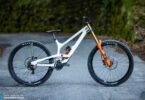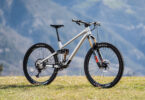Mountain biking is becoming more feminine. Women are turning up the heat in ever more disciplines, and product trends are moving with them. Unfortunately, they often tend to be pink and fluffy. Which of these are nothing more than Barbie bullshit and which really help women progress on their bikes? Ladies, this one’s for you!

Finally, mountain biking is no longer just a man’s domain, and we love that. It never was, you say? Okay, just like men, women have been competing at the annual UCI Downhill World Championships since the early 1990s – but how? With no live broadcasts, with a small field of competitors and second-class sponsorship contracts. It took a long time for women to get involved at all in some other disciplines. We saw the gender barriers break down in the freeride scene just a few years ago, for example. Male freeriders are now making way for women who are actively pushing the gravity community just as much as their Y-chromosome-carrying counterparts. The female riders’ scene is getting stronger: Red Bull Formation, the sister event to the infamous Rampage, has given women their very own freeride stage since 2019. The British rider Veronique Sandler is mixing a male dominated playground up, with dual crown forks, dirty jeans, big airtime, and a shovel in her hands. And the young New Zealander Jess Blewitt is the first woman ever to join the boys at the start line of the gnarliest downhill race on the calendar, Red Bull Hardline.

Need more examples of female shredders? Sure! Since 2020, Jules McLean has been the first top-tier mechanic to tinker on the bikes of pro racers like Rachel Atherton, who doesn’t just seem to win all the races, but also builds world-class mountain bikes together with her brothers, Dan and Gee. By the way, we got Rachel’s input on this article, and she added some good points for us to think about, but more on that later.
Does having boobs make a difference to how I set up my cockpit?
Rachel Atherton
Women’s know-how on and off the bike is growing and on par with that of their male peers. Ladies ride, win, dig, jump, tinker, and build.So, it’s all looking rosy for female riders, isn’t it? Not quite! Brands are still struggling to offer women the bikes and components that they really need. And by that, we don’t mean the frame colour. Rather, do they need the same frame sizes as men? Do they need different components? And which styles are available for them to choose from when it comes to the kit? There remain a lot of questions to be answered. That’s why we went to Schladming with four female riders and a wide selection of products. We wanted to find out what ladies really need to progress on their bikes – for all female riders, but also as an appeal to the brands and manufacturers out there.

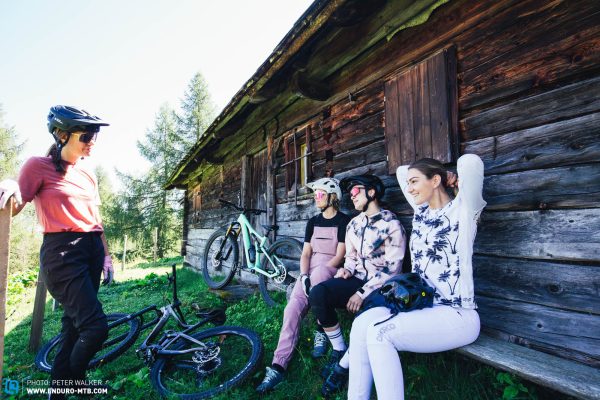
#girlsridetoo was yesterday
Of course, they ride too! The claim “girls ride too” might have been important in opening the doors to ladies a few years ago. By now, we know they can ride – and, boy, can they ride! The road to mountain biking has now been paved for women. It’s no longer a question of whether they ride, but of how suitable the equipment is that is available to them. And that’s exactly what we want to tackle in this article. What does it mean to make good products for female riders? Which issues do bike and equipment manufacturers urgently need to address? And how many female riders like pink flowers on their kit? Even with the bikes themselves, there is no agreed view of how women should be catered to. With Liv, GIANT created a sister brand whose products are specifically designed to meet women’s needs. Trek and Specialized, on the other hand, claim that their models are unisex, allowing women and men to choose their bike based on the frame size. Pivot don’t differentiate between male and female either, but rather sent us a bike designed especially for smaller, lighter riders, regardless of gender. So, what’s it going to be?

When does it make sense to distinguish between male and female products? In which case do female riders benefit from not simply having to resort to the men’s version? And why do some manufacturers provide supposedly feminine features that don’t actually improve (or sometimes even impede) their performance? In short: which products are nothing more than Barbie bullshit and which ones really let ladies progress on their mountain bikes?
We sent our girls to the trails with a combination of women’s specific and unisex products to see which of them they love the most. Some of the bikes and products were in-your-face-female, others were more discreet and couldn’t be attributed to any gender. However, as soon as they hit the trails, it became clear what really mattered: riding amazing trails! So, it doesn’t matter whether it’s a lady version or unisex? I think we need to ask a little more specifically…
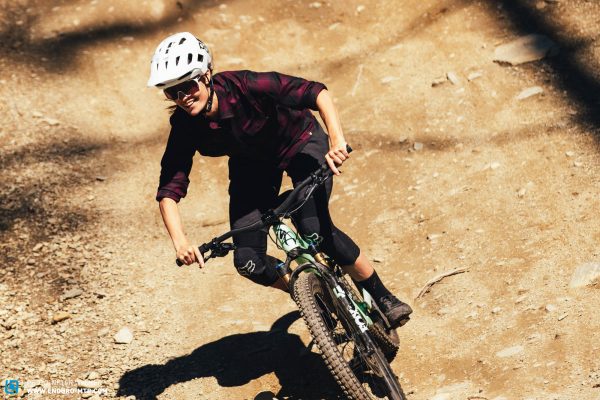

The ladies are there – Many brands aren’t yet
This should go without saying, but as soon as they’re on the trail, women ultimately want the exact same thing as men: to have fun, enjoy the time with friends, progress – as painful as that can be – and a minimum level of comfort on the bike. Oh, and to express their own style! Too many demands at once? No, that’s got to be doable. After all, they can do it for men. Now it’s the ladies’ turn!

Just one wrong piece of kit can cause pain and discomfort, or even pose a danger to safe riding and ruin a trip. As such, women should pay careful attention to certain aspects of their bike and equipment to make the most of the trails instead of getting frustrated and struggling with inappropriate gear. In these instances, female-specific products can be the solution, but not necessarily always. In some areas, unisex options are just as good or even better. We didn’t just give the topic a lot of thought ourselves but also consulted renowned manufacturers to find out more about the requirements that good women’s bikes and components need to fulfil. On the one hand, we looked at the bikes themselves, their geometry, sizes, and the most important components that are relevant to women’s needs. But we also looked at the kit and protective gear. Let’s go!
Women’s bikes ≠ small men’s bikes with lower end components
What makes women’s mountain bikes different? Specific geometry? A different concept entirely? Or just a few specific components? Are frame geometries derived from male or female bodies? Can you simply “shrink it and pink it”? And what are the advantages of a dedicated women’s bike like the Liv?
From Trek’s point of view, there’s not much to it: “We make no difference between women’s and men’s bikes, as this simply doesn’t make sense.” As long as the frame size is right, the individual fit is determined by individual components such as the saddle and cockpit, they say. What about the look? “Depending on the rider’s preference, we offer a wide variety of standard colour schemes,” the American brand conclude. Pivot don’t make any differences based on gender either. The Shadowcat, which was one of the bikes we rode in Schladming, isn’t classified as a women’s bike, but rather as a bike that’s suitable for smaller and lighter riders thanks to its light weight and added compliance, catering to many women and some men.



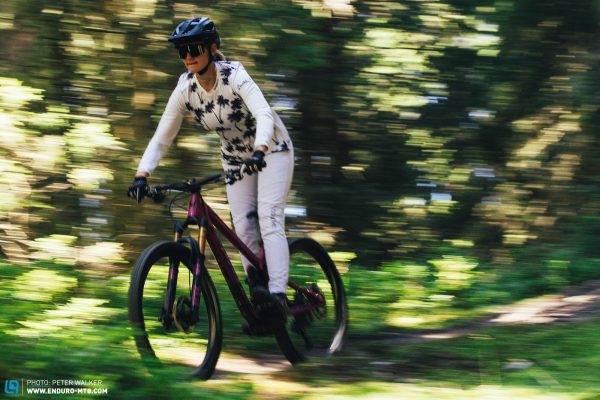
Specialized also agree with this approach, differentiating according to rider size instead of gender. “Body proportions vary just as much within a gender as they do between men and women,” according to the makers of the Stumpjumper. Instead, they prefer to focus on the equipment and components that they believe truly make a difference.


But why do other brands have women’s specific models then? Liv go the extra mile, setting out to design bikes especially for women. What are the benefits of this approach? We can’t know without looking at the details.


How does Rachel Atherton do it?
British rider Rachel Atherton isn’t just building on her extraordinarily successful downhill career, she has also started designing her own mountain bikes together with her brothers, Dan and Gee. The eponymously named Atherton Bikes enduro bike blew us away in our 2022 trail bike group test. So, Rachel must know: what boxes does a mountain bike have to tick to provide female riders the best possible experience? “Having a perfectly fitted bike is one of the key factors that can improve your riding experience, but the issue of male or female just isn’t an issue for Atherton Bikes. The key factors (height, arm span, inseam) vary between different men and different women, not just between the sexes.” And to allow riders to find the perfect fit, the Athertons offer their bikes in a whopping 22 different sizes. This is made possible by their special manufacturing process, using carbon tubes and additive manufactured lugs.

So, Rachel, do boobs make a difference to the cockpit setup or not? “How you set up your bike should be governed by your own preference, how aggressively you want to ride, what makes you feel more comfortable. Let’s not make generalisations based on gender. It’s what’s inside your head that really counts.”

Clearly, we can at least say that a women’s mountain bike can’t just be an affordable, low-end version of a male model, according to the motto “She just wants to try it out”. Newcomers, especially, should make sure that their equipment fits, otherwise, they’re unlikely to have any fun. No one enjoys a bike that’s specced with budget components from front to back. The following components are particularly important.
Saddles
Women naturally have more widely spaced sit bones than men – for giving birth, and all that. Therefore, women need saddles that take this into account, offering a wider, more supportive surface to sit on. Trying to get used to an unsuitably narrow saddle just because that’s the saddle the bike came with is a pain… in the ass. It’s better to take some measurements and get the right saddle width. And don’t worry, even slightly wider saddles can look sporty, like the Specialized Power Mimic. The days of ladies’ saddles being big, bulky foam sofas are long gone.

Grips
Like the saddle, the grips are one of the main contact points between human and machine. And as different as people are in size, so different are their hands. If you’ve got small hands with short fingers, you’ll have a much easier time holding on to a suitably skinny grip. It’s worthwhile upgrading the grips, because the connection between our hands and the bike determines how good and confident we feel on the bike. Fortunately, you’ll find an extremely wide range of grips on the market. Besides, grips aren’t super expensive either.

Brakes
Let’s stay with the hands and extend our digits – that’s right, we’re talking about the brakes. Can you reach the brake levers, or won’t your fingers stretch out far enough? Women are lighter than men, so they don’t need high-end brakes, right? Wrong! Yes, women are usually lighter than men and most brakes provide them with sufficient stopping power. But it can be difficult to reach the levers comfortably if you’ve got smaller hands. In this case, it helps to have high-end brakes that aren’t just powerful, but also give you lots of lever reach and throw adjustability. Unfortunately, it’s right here that some brands save on their mid-range builds, since brakes offering more adjustability are usually more expensive, of course. But you can’t put a price on something as critical as being able to reach the brake levers, instilling you with confidence and allowing beginners to progress a lot quicker. It’s an additional expense that quickly pays off in fun on the trails!


Pedal size
The third point of contact with the bike is heavily dependent on personal preference. You’ll have to find out for yourself how much grip you want, but if you have small feet, it’s usually safe to say that you’ll be happy with smaller pedals. Smaller pedals have the benefit that they give you more clearance when cornering or navigating tight terrain. Like the grips, there’s an enormous variety of pedal shapes, colours, and even materials to choose from. And they’re usually not included with the bike, always leaving it up to the rider to decide how much grip and support they want. You could also go with a certain colour to match or contrast your new bike. If you’ve got no idea, we’re happy to give you an introduction to this fast-spinning world with our comprehensive pedal group test.

Suspension
There’s one thing light girls (and boys) should certainly pay attention to on the suspension: a sensitive response! Don’t be dazzled by the supposedly best suspension forks and shocks that the pros out there ride, because the stiff, flagship enduro models aren’t the ultimate one-size-fits-all solution for every rider. Better ask yourself how much stiffness you really need or can handle. Weigh less than 90 kilos and usually avoid rooftop-drops? Then you don’t need the beefy RockShox ZEB, but will fare better with a Lyrik or Pike, which are lighter and more compliant, providing more comfort and grip. Save yourself the added weight of the ZEB but dare to use the adjustment dials to get the most from your fork and shock by perfecting the setup and allowing the suspension to respond as sensitively as possible. You might want to check out our article on the perfect suspension adjustment for some insider tips and tricks.


Handlebar width (and thus stiffness)
Have you ever tried breaking a wooden stick with your hands? Of course. And then tried to break it in half again? You’ll have found that it gets difficult rather quickly. Handlebars are also designed to be durable but still somewhat compliant at a certain width. By shortening it considerably, the handlebar loses its desired flex and suddenly feels rock hard – like when you keep breaking a stick in half. It’s uncomfortable and wears out your hands. If you need a narrow cockpit, you’ll be better off with a 31.8 mm handlebar instead of a 35 mm diameter version and one made of aluminium instead of carbon. No, that’s not a typo! The natural compliance offered by aluminium can feel better than its heavily trimmed, super-stiff carbon counterpart. Even a carbon specialist like Cesar Rojo from UNNO prefers running a skinny, compliant aluminium handlebar, as he explains in our article on carbon myths. And you can find out why stiffer doesn’t always mean better in another article in this issue. Give it a try!


From the grips to the saddle and down to the pedals, there are certain components that have a significant influence on the amount of fun female riders can have on the bike. It’s worth taking a careful look at these before buying or to budget for upgrades where necessary. Of these, the saddle is the only product that’s designed specifically for women, because it must accommodate the female anatomy. All the other components mentioned are unisex and should simply be chosen according to your size and adjustability requirements. Complete women’s bikes such as those from Liv already address some of these aspects. That said, if the frame size fits, any unisex bike like the Trek or Specialized can be adapted to suit female riders. So, all that still speaks for women’s specific models are the looks? Ultimately, however, beauty is in the eye of the beholder. The bottom line is that it’s just a handful of components that play a key role for female riders. First of all, you’ve got to have the correct frame size. If you’re handy with tools, you can upgrade and adapt the rest in your own time.
Gear – As long as it’s pink and fluffy, right?
What about riding gear for women? Unlike the bike itself, which should only contact the rider at the grips, the saddle, and the pedals, the fit of the riding gear encompasses a lot more of your body. Further complicating matters is the protective equipment consisting of a helmet, knee pads, gloves and perhaps even a back protector. Besides being functional, it should fit well, do justice to the female anatomy, and look damn good!

The tricky thing for manufacturers is that female body types differ more from each other than those of men. Big or small bust? Wide or slender shoulders? Straight or curvy hips? All this requires a different cut, and we haven’t even gotten to the rider’s size. But hey, this is what clothing labels do, so it shouldn’t be too much to ask. Below, we’ve got a few style ideas for ladies.
Anything goes
No, we’re not copping out when we say; just do whatever floats your boat. It’s just easier for you! In the end, you shouldn’t be worrying about how you’re dressed, but rather enjoy the feeling of blasting down the trail aboard your bike with the wind in your hair.
Okay, protective gear is a must. You must have the right size helmet so that it fits snuggly on your head. We’d strongly advise against wearing the XL gloves that you borrowed from your boyfriend, but rather get yourself a pair that fits… well, like a glove… allowing you to work precisely with your fingers. And you shouldn’t even have to think about the protectors while riding, instead, they should stay where they belong and fade into the background. It’s possible if you go to the trouble of trying on a few products and finding out which of them best suits you. And then the party can start.


If you’ve got the protective gear sorted, this is the part where everything goes, by which we mean your look on the bike. Do you like bright colours, or do you prefer staying low-key? Tight-fitting racer look or baggy corduroy trousers like Brage Vestavik’s sister? Flowers or skulls? There isn’t much for us to say about this, because you know your own style a lot better than we do. Let’s be clear: women’s riding kit can but doesn’t have to come in emphatically feminine floral print and with pink details, even if it’s something we see quite often. And if that’s your thing, great, go for it! But if you prefer a minimalistic look or murdered-out-black, that’s cool too! Anyone who wants to look gangster should be allowed to look gangster – no flowers in sight. The market for ladies’ kit is significantly smaller than the men’s equivalent in mountain biking. Nevertheless, the first brands that take the demand seriously have stepped up, offering new, fresh styles that go beyond the stereotypical floral patterns. And if you can’t find what you’re looking for, you can just grab an old pair of jeans and a T-shirt and off you go. We’re not here to tell you what to think is cool or comfortable.


Reducing women on the bike to barbie doll looks doesn’t do them justice in terms of style or function. British rider, Veronique Sandler, for example, seems to choose her bike clothes according to whatever she’s got lying around and won’t instantly get destroyed. She wears the same trousers for digging and shaping as she does when hitting the jumps she’s just built. Her style clearly puts functionality first. Which we think is a cool and casual statement far off from categorical women’s kit. Our four girls also like combining typically feminine items with a slightly more unisex look. If it performs as it should on the bike, there are no rules. Just decide for yourself what you like.

It all comes down to a few components
Three of the four bikes that our girls rode in Schladming weren’t women’s specific models. What do we take away from this day, except good times on the trails followed by a round of delicious wine spritzers? What is it that really allows women to progress on their bikes? We’ve identified certain components that really make a difference to the amount of fun female riders can have on the trail. These include, above all, a women’s specific saddle, appropriately dimensioned grips, and a sufficiently compliant handlebar. In the case of the brakes, their stopping power is less important than the adjustability of the levers. None of these aspects require a separate, womens’ specific mountain bike, just the right frame size and well-specced components. Womens’ specific offers can make sense, as they can be specced accordingly. However, this approach is generally suitable for small and light riders and doesn’t require a ladies’ label. Fortunately, female riders already have cool options when it comes to clothing and protective equipment. The market is growing and there’s more on offer than the usual floral patterns. And if you can’t yet find the pants and jersey in the design that you’re looking for, the things you already own will also do for now. Ladies, wear whatever you feel most comfortable in when riding, because that suits you best!
Ladies’ equipment doesn’t necessarily have to be pink, as long as it fits and performs as it should. The amount of fun female riders can have on the trail is determined by the frame size and the suitability of certain components such as the saddle, grips, handlebar, and brake levers. But we’re not about to prescribe which style of kit you’ll look best in on the bike. Girly? Gangster? Racer? Surfer? Or something completely different? It’s your style, so you decide.

Did you enjoy this article? If so, we would be stoked if you decide to support us with a monthly contribution. By becoming a supporter of ENDURO, you will help secure a sustainable future for high-quality mountain bike journalism. Click here to learn more.
Words: Moritz Geisreiter Photos: Peter Walker




